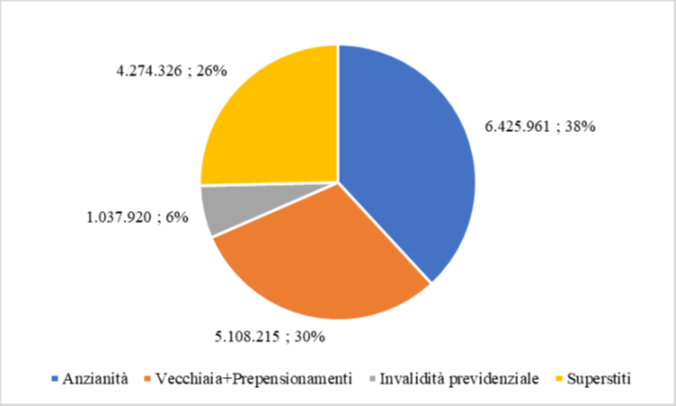Inps, truth and nonsense about the retirement age

What can be read in the end-of-mandate report by Guglielmo Loy, president of the INPS Steering and Supervisory Board (Civ), Giuliano Cazzola's comment
In one of Woody Allen's best films “ Me and Annie '' we see a scene that shows the protagonist (Allen) on one side and Annie, his partner (played by Diane Keaton) on the other, both in session by their psychoanalysts who ask the same question: how many times do they make love in a week. '' A few times, only four, '' replies Allen; "Many, four," says Keaton.
This episode came back to my mind (I am a lover of Allen's first films) when I read an excerpt from the end-of-mandate report by Guglielmo Loy, president of the INPS Steering and Supervisory Board (CIV), the body where the representatives of the social partners (the stockolders). In Italy, " the retirement age is now high and growing steadily ", reads Loy's report.
As regards the average retirement age, the elaborations on the data collected by the CIV show that – taking as reference only the early and old-age pensions – the retirement age among private employees is currently equal to 64.1 and 63, 2 years, respectively for women and men. Similar values (63.9 and 63.5 for women and men) are observed in the public sector, while the effective retirement age is higher (64.8 and 64) in autonomous INPS managements.
These data "clearly deny the rhetoric of those who still consider the retirement age in Italy to be limited thanks to the alleged too many loopholes that would be offered by our pension regulations". It looks like an update of an old working-class song: '' If 63 years old seems too few, you try to work! ''.
This stance is singular, also because – as the document correctly observes – in indicating the average age, only old age and seniority treatments are taken as a reference. While for the old-age pension there is a legal limit of the retirement age (67 years, however blocked until 2024 with regard to the automatic adjustment to life expectancy), for that of ordinary seniority there is only a contribution requirement to any age (42 years and 10 months for men and one year in the chin for women) blocked until the end of 2026. While the age requirement of 62 was required for the quota 100.
Loy's average age at onset has more to do with Trilussa chicken statistics than reality. And it is not fair to rig the cards for those who have an institutional role. The president of the CIV knows very well that the majority of male workers in Italy are able to retire at around 62 years of age, while women (who in the private sectors above all have a more indented contribution history) owe the most sometimes settle for the old-age allowance.
It is no coincidence, in fact, that the CIV document recognizes that the average retirement age, in all schemes, is higher for women. In the same way, if Loy has forgotten the iron logic of the numbers that make Italy the country of the advance, we remind him with the following cake where it is shown that the number of advance payments exceeds that of about 2.2 million pensions. old age (which is considered the '' normal '' regime in all civilized countries, which also allow for forms of early exodus).

And at what average age at the start of retirement, do you retire early in Italy? Let's take the data provided by the Court of Auditors in its latest Report on the coordination of public finance (RCFP 2021):
'' For early retirement pensions the average age registered in 2020 is 62 years. The figure is lower than that recorded in 2019 (62.3 years), but remains influenced by retirements in derogation with Quota 100 and, to a lesser extent, by the quarterly window for access to early retirement, again introduced with the legislative decree 4/2010. . The value is in fact higher than that presented for retirement pensions paid in the three-year period 2016-2018, in the absence of Quota 100: respectively, an overall average age of 60.6 – 61.0 and 61.0 was recorded years. This means – explains the Court – that the people able to meet the ordinary legal requirements to access the early retirement are "young" between 60-61 years. The data are distorted by the access of "quotacentists", who can access from 62 years of age and 38 years of contributions, are on average "older" and are "many". Consequently, a not entirely intuitive fact occurs and that is that Quota 100 has led to an increase in the average age of retirees ''.
As for the '' ways out '' which, according to the CIV, '' would belong to rhetoric '', President Loy should clarify with the OECD and with its periodic publications (Pensions at glance). According to the Organization of Developed Countries, Italy highlights yet another paradox in a delicate sector such as social security . Although the "legal" age (normal / standard) is one of the highest, the actual age – which takes into account all the existing institutions and the set of derogation rules or exit routes – is instead significantly outside below the OECD average . It is noted that in 2018 Italy allowed on average to leave work at 63.3 years (62.1 in 2016) for men and 62.5 (61.3) for women, values that were compared with 65.4 (65.1) and 63.7 (63.6) of the average for OECD countries. In the international reality, the distance between effective age and legal age assumes a positive sign (ie one remains at work on average beyond the standard age) for men in 24 of the 36 OECD countries (in 16, for women). Italy, which, as we have anticipated, has one of the highest legal exit ages (67 for men and women) is, with Germany and France, in the group of countries where the effective age is lower than that standard, and the distance is the largest of those observed (-4.4 years for men and -4.2 years for women).
Basically, taking the 67 years foreseen for the old-age pension as a normal parameter for us (with a minimum of 20 years of contributions), leads to the dead end of a treatment largely reserved in fact to workers and sectors weak workers in the labor market who, during their working life, are unable to accrue high contribution requirements such as those necessary to be able to anticipate retirement regardless of age.
Loy's average is therefore unbalanced between the effective retirement age of women on retirement by way of old age and that of men on early retirement. It would be appropriate to explain this paradox in its real terms. Because this is where the OECD gets lost in describing the emergency exits that transform the system into a sieve (ordinary early retirement, woman option, forty-one / precocious, quotacentists, worn out and disadvantaged, social bee). Speaking of '' ways out '' or rather '' shortcuts ''.
This is a machine translation from Italian language of a post published on Start Magazine at the URL https://www.startmag.it/economia/inps-verita-e-frottole-sulleta-di-pensionamento/ on Sat, 22 Jan 2022 08:25:59 +0000.
